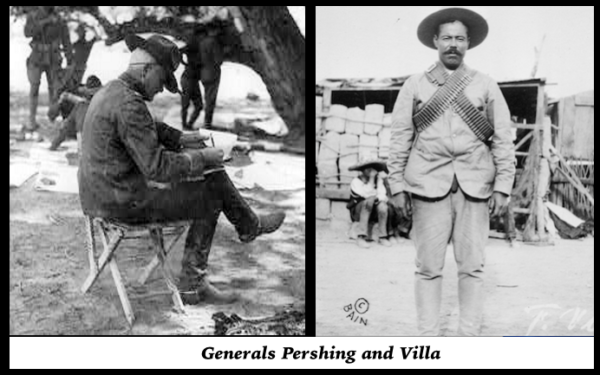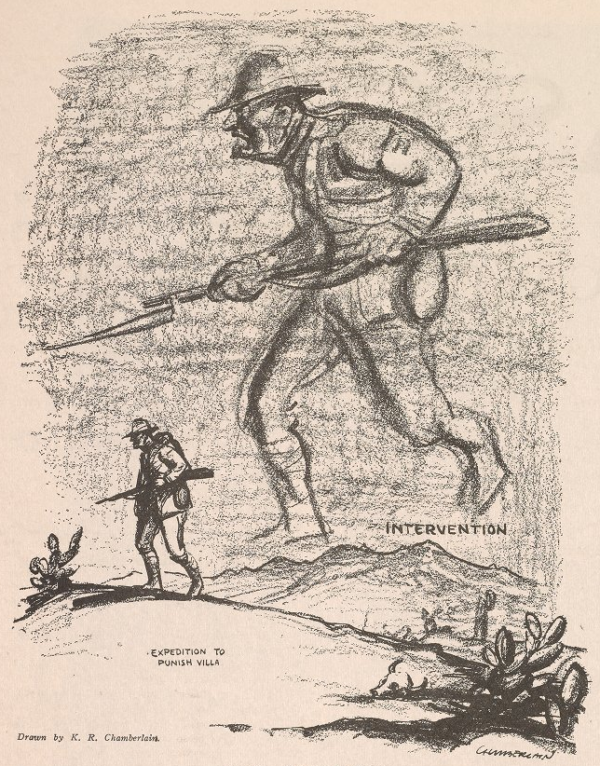Yo, Pancho Villa, fui un hombre leal
que el destino trajo al mundo para
luchar por el bien de los pobres y que
nunca traicionaré ni olvidaré mi deber.
Wednesday June 21, 1916
From The Masses: John Reed on the “Punitive Expedition”

From The Masses of June 1916:
The Mexican Tangle – By John ReedAt last we have got ourselves into the apparently inextricable snarl in Mexico that the interventionists have always wanted. When Villa raided the town of Columbus, New Mexico, there was so much evidence that certain American interests were concerned in inciting him to cross the line and murder American citizens and soldiers, that even President Wilson made a public statement to the people of the United States warning them against “the sinister influences at work in this country” to force intervention on any pretext.
The preparedness advocates, equally unscrupulous in their desire to make this a military nation in order that a strong army and navy shall be built up to encourage wholesale exploitation by American business men abroad, and to guard foreign interest of American speculators when they are obtained, do not hesitate to twist the events of the life and death struggle of the Mexican peons for freedom so as to bolster up their arguments.
When Wilson refused to recognize Huerta, a treacherous murderer and adventurer, and when Huerta refused to be unrecognized, they told us that America was being “humiliated” and that “Mexico was laughing us to scorn.” When an irresponsible minor officer refused to salute our stainless flag, they said again that “Mexico was making a laughing stock of us.” When Villa, with a hundred odd followers, came over and shot up Columbus, they talked about the Mexican people “invading” the United States.
Once before the interventionists and the military party forced our army and navy to Vera Cruz, whopping it up for war and conquest all the time; stock in dishonestly obtained American concessions in Mexico flew skyward. But the President managed to get us out of Vera Cruz again without any damage being done.
When the punitive expedition went after Villa a month ago, there was another cry that intervention was coming, and this time those of us who know Mexico believed, and still believe, that they were right.
Things have grown to look more and more sinister down there. First it was our request to be allowed to use the Mexican railways to transport supplies and troops to the “punitive expedition”; refuse by Carranza. Then came the rumors from Washington that Carranza had asked Washington to withdraw the American troops from Mexico, since confirmed.
All this time a hundred different Mexican sources gave out their scarcely veiled hostile opinion that the Carranza soldiers could capture Villa unaided, and the Americans never could. It was quite evident that the Mexican army was making very little attempt to do so. This is not astonishing; it looks like a miracle of self-restraint that the armies of the various Mexican generals have not united to attack the Americans before this. That attack is to be expected, for the Mexicans know as well as we do that this is the end of the working out of their revolution.
On April 14th the de facto government of Mexico gave out for publication the dispatches in the secret exchange of notes between Carranza and the United states, and revealed Carranza’s terrible anxiety in the untenable position in which he now finds himself. If he permits the American army to march all over Mexico and stay months in the illusive chase of a bandit whom even Diaz’s ten thousand rurales could not capture in twenty years, the Mexican peons will turn against their leader who encourages those gringoes whom all Mexicans secretly feel are the enemies of Mexico; if, on the other hand, he orders the American troops to withdraw, why then he knows that we will refuse and that the peons will try to drive us out by force. In either case there is not much chance for the President to accomplish his desire of capturing Villa, and there is not much chance for Mexico.
Such ultimatums as “Huerta must go,” “The flag must be saluted,” and “Villa dead or alive,” leave very few loopholes for us to keep from conquering Mexico. When we don’t do what we threaten to, the interventionists find a great opportunity to shout that we are “humiliated.” Even after making these stern and dreadful boasts, the President up to now has had the courage to draw out of Mexico before it has been too late. But it looks as if he won’t be able to do it this time.
We have refused to order the troops out of Mexico until Villa is captured. And it is almost impossible that Villa should be captured.
This morning (April 15) the papers tell of the second attack upon United States soldiers on the outskirts of the town of Parral. Parral is the center of the old Villa country. Villa himself passed through there a week ago, bound south for the desolate Durango Mountains, where live a race of insolent and independent Indians who have never known oppression, and who are Villa’s blood-brothers. Even in the palmiest days of the Diaz regime the rurales kept out of that region. Criminals who escaped into the hills south of Parral were safe from further pursuit. It is an arid country of stony peaks, covered with cactus and sword-plants, without water; of bewildering trails winding through deep canyons and to the far camps of the charcoal-burners, who are Urbanistas and Villistas to a man-and gringo-haters as well.
All this part of the country was fed for twenty years by Villa and his band of outlaws, and protected against the rapacity and expropriation of the Diaz government officials and the rich. A large section of Carranza’s army, commanded by Luis Herrera, comes from this region. Besides this, most of the Carranza soldiers drawn from Northern Mexico are Villistas at heart, and the rest consider him a half-mythical monster with a charmed life, who is always victorious in battle. The Mexican regular soldiers would probably not aid Villa against Carranza at this stage of the game, because Carranza is now promising all that Villa once promised, and Carranza’s party is now the stronger. But when it comes to choosing between Villa and General Pershing, then Villa will get almost every Mexican’s adherence.
Remember it was the townspeople of Parral who fired on the American troops. In other words, it is at last the Mexican peons, the workingmen, the rancheros, their children and their wives, who are rising against further American advance into Mexico. And as the American troops go farther south they enter more and more deeply the Villa country, the country of the gringo-haters, the region where Madero lived and where he first talked to the people, and where after his death the revolution against Huerta began.
[Drawing by K. R. Chamberlain added is from
The Masses of May 1916.]
~~~~~~~~~~~~~~~~~~~~
SOURCE
The Masses
(New York, New York)
-June 1916
http://dlib.nyu.edu/themasses/books/masses062/1
The Mexican Tangle – By John Reed
http://dlib.nyu.edu/themasses/books/masses062/11
IMAGES
Villa Expedition by Chamberlain, Masses, May 1916
http://dlib.nyu.edu/themasses/books/masses061/6
Villa Expedition, Generals Pershing & Villa, begun Mar 14, 1916
https://en.wikipedia.org/wiki/Pancho_Villa_Expedition
See also:
Villa Expedition
https://en.wikipedia.org/wiki/Pancho_Villa_Expedition
Insurgent Mexico
-by John Reed
D. Appleton, 1914
To read:
https://books.google.com/books/reader?id=A9RmAAAAMAAJ&printsec=frontcover&output=reader&source=gbs_atb&pg=GBS.PR3
Kenneth (K. R.) Chamberlain
http://spartacus-educational.com/ARTchamberlain.htm

